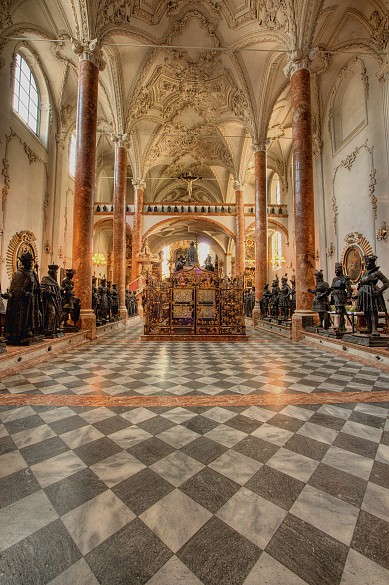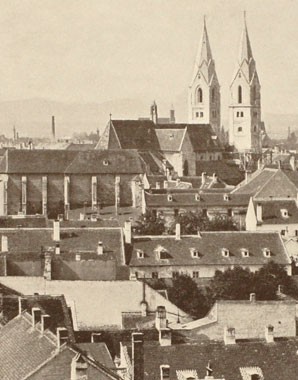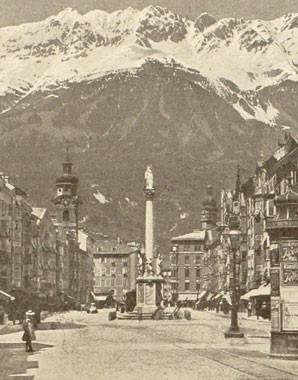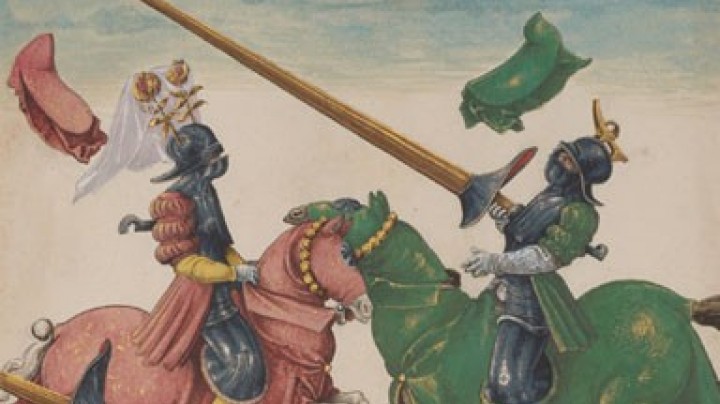Maximilian I: art in the service of politics
With his impressive public presence and his deftly operated ‘media policy’, Maximilian was a very popular monarch during his own lifetime. Concerned to glorify himself and his reign, he worked systematically on his ‘Memoria’, the aim of which was to historicize his person for posterity.
Maximilian’s verdict on historyHe who makes no memory of himself during his lifetime will have none after his death, and will be forgotten with the tolling of the final knell.
To this end he published a number of autobiographical works. In Weisskunig, which remained a fragment, he gives a romantic account of his youth, and in the verse epic Theuerdank of his courtship of Mary of Burgundy. His passion for the world of chivalric jousting is evident in his tourney-book entitled Freydal. Maximilian was personally involved in the creation of these works, which were however revised and edited by scholars at his court. The most important of these was his secretary Marx Treitzsaurwein.
His intended readership was posterity. Contemporary views of Maximilian varied, however. While he had himself glorified as Hercules Germanicus, he was ridiculed by his adversaries. The Florentine humanist and philosopher Machiavelli, for example, conceded that the emperor had a great love of art and science, and celebrated him as a magnanimous military commander who treated those he had vanquished with fairness. However, he also emphasized Maximilian’s dark side, citing his inconstancy and the consequences of his financial problems that ‘sullied’ his imperial dignity.
Maximilian was a skilful exploiter of the modern media of his times such as printing, particularly in the use of the pamphlet, the antecedent of the modern newspaper, with which he could control the dissemination of news. The emperor attacked his French adversary, King Charles VIII, not only on the battlefield but also through his use of these media.
In Austria Maximilian is primarily known as the ‘last knight’. He successfully stylized himself as the embodiment of the medieval ideal. However, it would be judging him too narrowly to reduce him merely to a character from the Middle Ages. Maximilian was a typical product of the time of change between the Middle Ages and the Renaissance. His biographers have pointed out both modern and archaic elements in his personality. His ‘cult of chivalry’ aimed at reviving medieval traditions in a new guise. The code of chivalry shaped him as much as his openness to modern methods of administration and technical innovations in warfare, for example artillery and the use of lansquenets.
Both politically and geographically Maximilian ranged far and wide. As ruler over territories that were scattered over western and central Europe he was constantly on the move between Burgundy, the Alpine lands and northern Italy. His preferred residences in the Austrian hereditary lands were Wiener Neustadt and in particular Innsbruck, where he had the Hofburg extended on a grand scale. Today only traces of this remain, as the late Gothic character of the palatial complex fell victim to the remodelling commissioned by Maria Theresa in the eighteenth century. The advantage of the city for Maximilian lay in the geopolitical situation of Tyrol at the intersection between north and south, and, given that he was constantly short of money, in the proximity of the rich silver mines centred around the town of Schwaz. Under Maximilian Tyrol flourished. The rich architectural and artistic legacy of the late Gothic age is still evident in the region, and Maximilian continues to be a popular historical figure in Tyrol.
One of the focuses of Maximilian’s public relations work was his ambitious genealogical and heraldic programme. To disseminate this he made use of the modern media of his times, commissioning easily reproducible publications which gave visual form to his claims to dominion. Drawing on the ancient Roman tradition of the imperial triumph he published his Triumphzug (Triumphal Procession), an elaborate series of printed woodcuts illustrating a fictitious event.
The Ehrenpforte (Gate of Honour) in the form of a classical arch of triumph is a masterpiece of early printing. It was created mainly by Jörg Kölderer, a versatile artist at Maximilian’s court, with contributions from Albrecht Dürer and Albrecht Altdorfer. A large-format work embellished with colour and gilding, it was sent to other European courts as a statement of Maximilian’s monarchical claims. The emperor also embarked on a magnificent illustrated history of Germany which never got beyond the preliminary stages, and commissioned genealogical treatises embedding him in a fictitious lineage that stretched all the way back to Noah.
The realization of all these notions in architecture can be seen in Innsbruck’s landmark Goldenes Dachl (Golden Roof), a court loggia with a perfect view of the city’s main square which is decorated with allusions to Maximilian’s monarchical programme. His armorial tower in the Innsbruck Hofburg, commissioned with the same intentions, has not been preserved in its original form.
The city is also home to Maximilian’s greatest project in the field of the fine arts, his monumental cenotaph in the court church at Innsbruck. This is not a tomb (Maximilian is buried in Wiener Neustadt), but a visual demonstration of the ideological programme of the dynasty, which had recently developed from a regional force into a determining power in Europe. The statuary – known in local vernacular parlance as the Schwarze Mander (Black Men) represents Maximilian’s forebears, real individuals as well as ideal fictitious figures. Begun in 1502, this important work was unfinished on Maximilian’s death but was completed by his grandchildren and great-grandchildren by 1584.
Emperor Maximilian died in Wels in Upper Austria in 1519. His death represented the final stage in a conscious act of dying, for he had made dispositions for his decease long before it happened. For the last four years of his life he always took a coffin with him on his travels and gave precise instructions as to how his corpse was to be treated. He wanted to be interred as a poor sinner, without pomp or circumstance, and did not wish his remains to be embalmed. He directed that his hair be shorn and his teeth be pulled, and as an expression of his contrition in the face of the sinfulness of his earthly existence he ordered his corpse to be scourged. Maximilian was buried beneath the high altar of the chapel of St George in the palace at Wiener Neustadt.
















